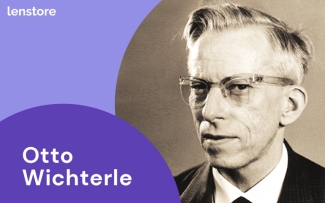Notable figures in eye care - Otto Wichterle
Otto Wichterle (1913 – 1998)
Otto Wichterle was an inventor and chemist born on 27 October 1913 in Prostějov, Moravia, in the former Austria-Hungary (now the Czech Republic). Wichterle's father was a successful machinist, but instead of following in his footsteps, Otto took to chemistry as his career ambition instead of mechanical engineering.
Wichterle studied chemistry at the Czech Technical University in Prague. In 1936, he gained his doctorate in organic chemistry and submitted a second doctoral thesis in 1939. As a researcher, he specialised in plastics and hydrogels, which proved invaluable in the field of ophthalmology.
Throughout his career, Wichterle's political beliefs often caused friction with the Czech communist government and academic institutes, which repeatedly refused funding for his experiments. This political pushback led Wichterle to pursue work at home, often with the help of his wife, Lidia, a physician.
Wichterle retired in 1979 but continued experimenting with other uses for polymers, travel, and computer programming. Following the Velvet Revolution of 1989, he returned to academia as the elected president of the Czechoslovak Academy of Sciences. Otto Wichterle died in his sleep at age 84 on 18 August 1998 in Stražisko, Czech Republic, not far from the village where he was born.
Otto Wichterle's contributions to eye care
Otto Wichterle's significant impact on eye care and advancements in vision correction methods are closely tied to his studies and experiments in chemistry. His development of plastic materials and research into hydrogels became an essential building block in the invention of soft contact lenses.
By developing a new material called pHEMA (polyhydroxy ethyl methacrylate) in 1959 with the help of his colleague Drahoslav Lím – the new compound enabled Wichterle to create soft lenses with a specific curvature that dramatically improved comfort during wear. This transparent polymer material could absorb almost 40% water and be moulded into specific shapes to suit the wearer's eye better. To create a production system for his invention, Otto Wichterle used his son's Merkur building toys to model his first hydrogel lenses, which he called Geltakt.

Other notable achievements of Otto Wichterle
Wichterle won numerous awards over the course of his career and received various tributes, including:
- Recipient of nearly 200 patents
- Authored 180 publications in leading scientific journals
- Elected first chairman of the Czech Academy of Sciences
- Asteroid 3899 (Wichterle) that orbits the sun is named as a tribute to him
- A Google Doodle celebrated the 108th anniversary of Wichterle's birth on 27 October 2021.
- Wichterle was awarded honorary degrees from two prestigious American universities – the Polytechnic University in Brooklyn and the University of Illinois.
Final word
Otto Wichterle is considered the inventor of current-day soft contact lenses constructed from hydrogel polymers and the patent and process of mass-producing them. Using the moulding method idea first described by John Herschel, Otto Wichterle's contact lens advancements made them available to the greater public through patenting and licensing to established optical companies like Bausch & Lomb (although without Wichterle's permission).
Wichterle and his protégé Drahoslav Lím knew that there was room for hydrogel lenses to be improved, and after he died in 1998, Lím continued to expand on his mentor's life work.



